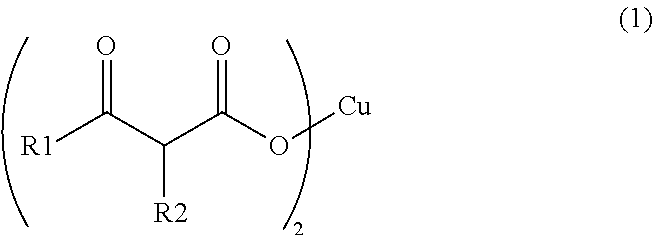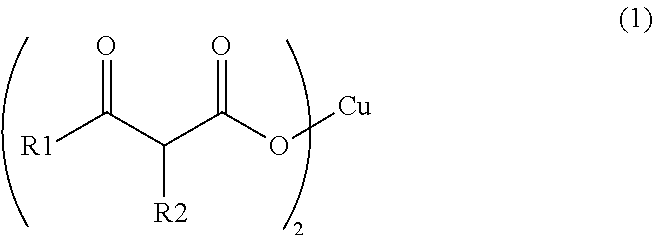Composition for forming copper pattern and method for forming copper pattern
a technology of composition and pattern, applied in the field of compound for copper patterning, can solve the problems of shrinkage of printed film, safety problems, etc., and achieve the effects of excellent safety, high conductive copper, and excellent safety
- Summary
- Abstract
- Description
- Claims
- Application Information
AI Technical Summary
Benefits of technology
Problems solved by technology
Method used
Image
Examples
synthesis example 1
Synthesis of Copper (II) Acetoacetate Dihydrate (in Formula (1), R1 is a Methyl Group and R2 is a Hydrogen Atom)
[0058]Into a NaOH aqueous solution (2.30 g, 24.0 mL) for hydrolysis, 6.24 g (48.0 mmol) of ethyl acetoacetate was added, and stirred under heating at 30° C. for 3 hours. After the three hours, the reaction mixture was cooled down to 0° C., and a 5 N HNO3 aqueous solution was added thereto to make the reaction liquid acidic. To the reaction mixture, 2.90 g (4.80 mmol) of a copper (II) nitrate aqueous solution was added dropwise, and subjected to magnetic stirring for 4 hours. The precipitated solid was taken out by filtration, and washed with ion-exchanged water and acetone to obtain 2.05 g (6.70 mmol) of copper (II) acetoacetate dihydrate in the form of light blue solid.
synthesis example 2
Synthesis of Copper (II) Butyrylacetate Dihydrate (in Formula (1), R1 is a Propyl Group and R2 is a Hydrogen Atom)
[0059]Into a NaOH aqueous solution (3.46 g, 24.0 mL) for hydrolysis, 11.4 g (72.0 mmol) of ethyl butyrylacetate was added, and stirred under heating at 30° C. for 3 hours. After the three hours, the reaction mixture was cooled down to 0° C., and a 5 N HNO3 aqueous solution as added thereto to make the reaction liquid acidic. To the reaction mixture, 4.34 g (7.20 mmol) of a copper (II) nitrate aqueous solution was added dropwise, and subjected to magnetic stirring for 3 hours. The precipitated solid was taken out by filtration, and washed with ion-exchanged water and acetone to obtain 4.37 g (12.2 mmol) of copper (II) butyrylacetate dihydrate in the form of blue solid.
synthesis example 3
Synthesis of Copper (II) 2-Methylacetoacetate Dihydrate (in formula (1), R1 is a methyl group and R2 is a methyl group)
[0060]Into a NaOH aqueous solution (3.46 g, 24.0 mL) for hydrolysis, 10.4 g (72.0 mmol) of ethyl 2-methylacetoacetate was added, and stirred under heating at 30° C. for 3 hours. After the three hours, the reaction mixture was cooled down to 0° C., and a 5 N HNO3 aqueous solution was added thereto to make the reaction liquid acidic. To the reaction mixture, 4.34 g (7.20 mmol) of copper (II) nitrate aqueous solution was added dropwise, and subjected to magnetic stirring for 3 hours. The precipitated solid was taken out by filtration, and washed with ion-exchanged water and acetone to obtain 2.81 g (8.52 mmol) of copper (II) 2-methylacetoacetate dihydrate in the form of blue solid.
PUM
| Property | Measurement | Unit |
|---|---|---|
| boiling point | aaaaa | aaaaa |
| pKa | aaaaa | aaaaa |
| particle size | aaaaa | aaaaa |
Abstract
Description
Claims
Application Information
 Login to View More
Login to View More - R&D
- Intellectual Property
- Life Sciences
- Materials
- Tech Scout
- Unparalleled Data Quality
- Higher Quality Content
- 60% Fewer Hallucinations
Browse by: Latest US Patents, China's latest patents, Technical Efficacy Thesaurus, Application Domain, Technology Topic, Popular Technical Reports.
© 2025 PatSnap. All rights reserved.Legal|Privacy policy|Modern Slavery Act Transparency Statement|Sitemap|About US| Contact US: help@patsnap.com



